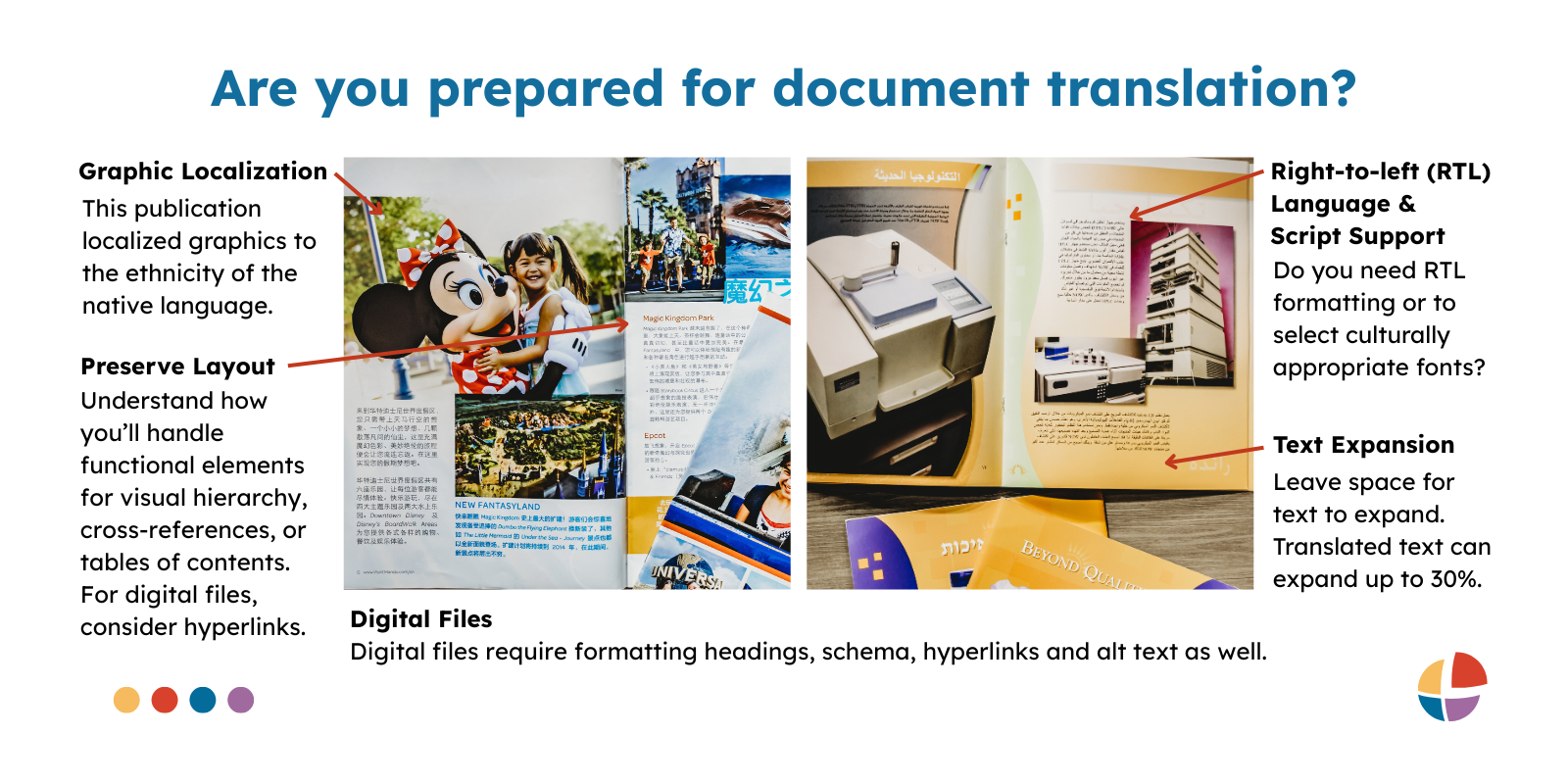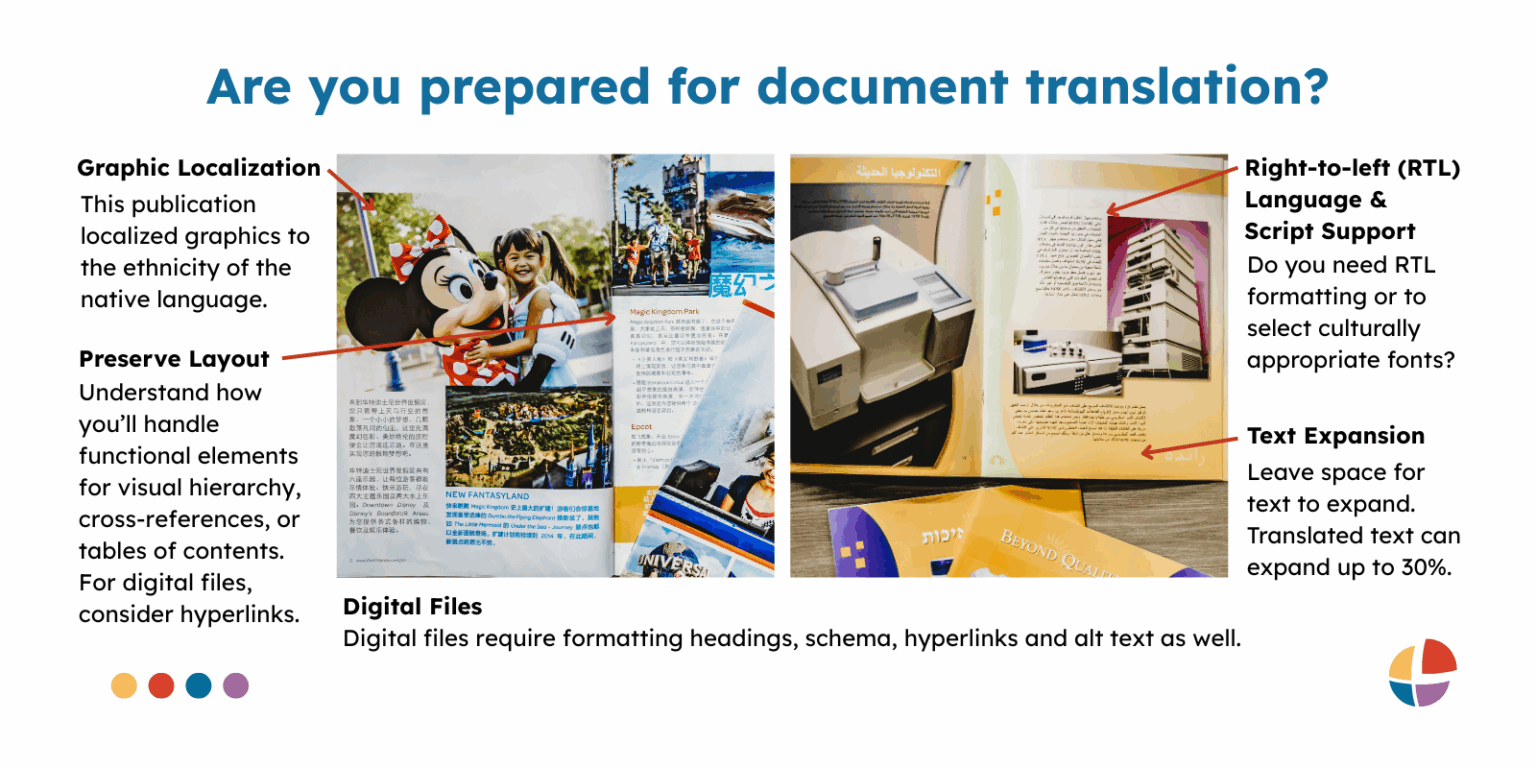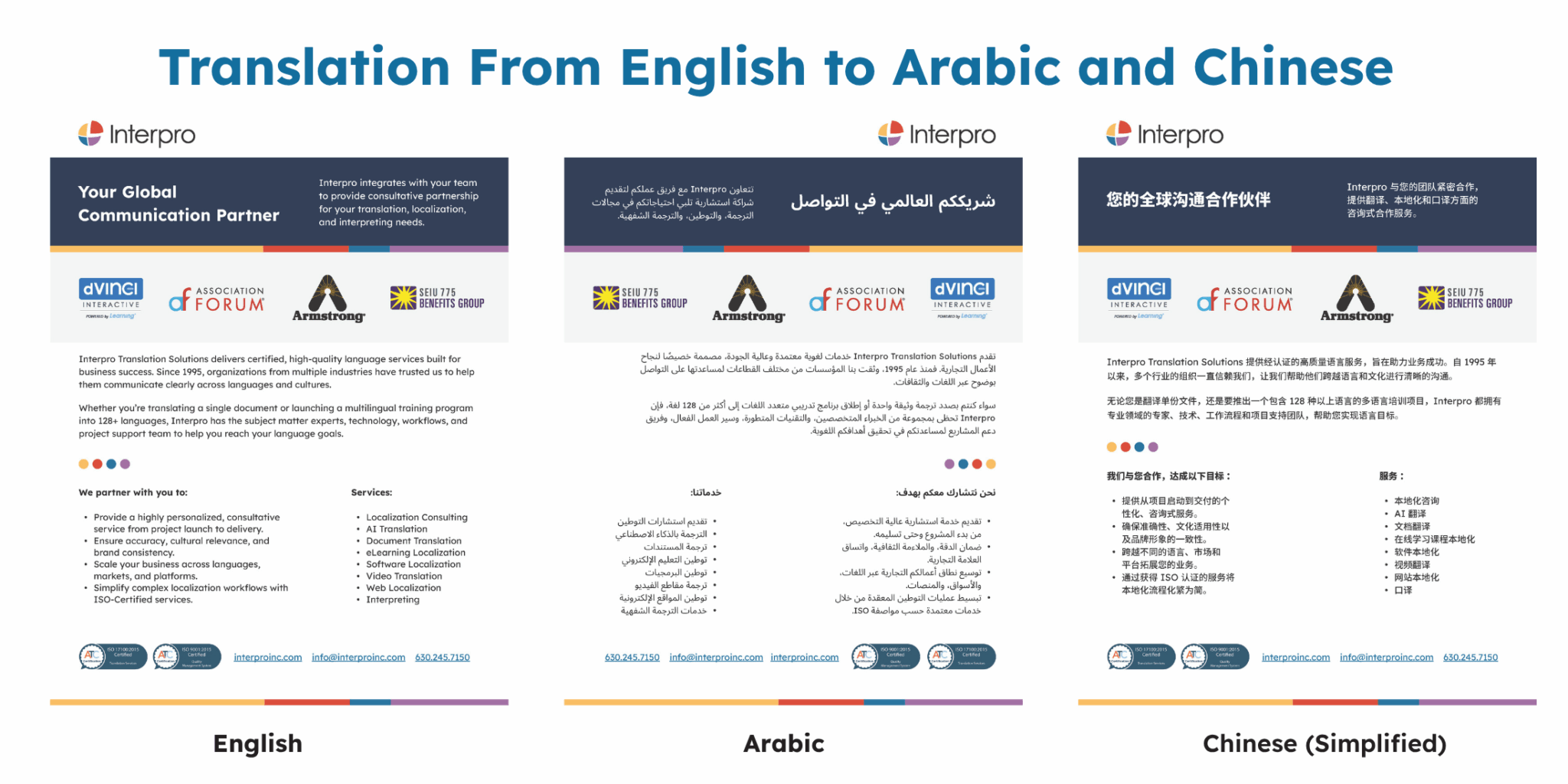
Preparing for document translation is crucial to avoid costly errors, delays, and confusion down the road. This article outlines seven essential steps to ensure a seamless, high-quality translation process.
Preparing for the Document Translation Process
Document translation into multiple languages requires preparation…
…before you send out a request for translation.
We often find ourselves advising clients on how to prepare for the professional document translation process long before they are ready to launch the translation. Being properly prepared for document translation helps result in a flawless final product.
So what are the first steps?
Before jumping straight into translating for your target audience, consider these 7 document preparation tips.
An example of Interpro translating one of our documents from English into Arabic and Simplified Chinese. Download the complete file translated into five different languages here.
1. Specify your target language(s)
While you may know the language you need translation for, there are some languages that require you to consider the region or countries you are targeting.
Trivia: What do Spanish, French, Portuguese, and Chinese all have in common?
Answer: They all have linguistic differences based on location.
Let’s say you want English to Spanish document translation. English to Spanish translation is a common request, and your translation provider will need to know which Spanish-speaking market you are targeting. There are numerous regions that speak Spanish that will have different localization requirements than a Spanish market located within the U.S.
2. Ensure documents are finalized before sending for translation
Take time when authoring your documents, and then ask your colleagues for their input. It is ideal to have several people review your documents prior to sending them out for translation. This helps to ensure accuracy, comprehensibility, and completeness.
If you’re working with PDFs: read the hidden complexity of translating PDF files. The article sheds light on some of the challenges of translating PDFs without source files, and some other document translation considerations.
It is best to thoroughly edit and finalize all your documents and provide the source files (InDesign, Illustrator, Canva) to your translation provider before starting the translation process.
3. Outline the project scope
How much content needs to be translated? What format is it in? What is the ideal completion date? Knowing these answers are key to your company’s planning.
You’ll also want to determine if you require Multilingual Desktop Publishing (DTP). This is the process of formatting documents after translation and translating graphics or other visual elements embedded in your document. A DTP specialist will be able to estimate how many hours they will take after analyzing the scope of the project: target language, file type, images, technical nature, and word count. Unless working with a very basic text file, you’ll likely need to account for some DTP time.

Estimating the scope also includes informing your translation team of any specific translation requirements:
- Specific terminology
- Terms that should remain in English
- Converting measurements
- Special requirements
- Delivery method
- Paper size
A clear project scope is one of the most valuable steps you can take to ensure a successful translation project.
4. Estimate a (reasonable) turnaround time
Timelines help to keep organized and on track as you work with your document translation partner to complete the project. As a professional translation agency, Interpro provides exact delivery timelines in the quoting process so you know exactly when your translations will be delivered.
Consider the follow scope of work:
- 100k words to translate
- 72 hours of Multilingual Desktop Publishing
Most translators can translate between 2000 to 2500 words per day. We use that as a reference and have a document translation delivery formula to determine a delivery date.
Interpro’s generic document translation delivery date formula:
Interpro’s generic post-DTP Linguistic QA formula:
Interpro client document translation timeline example:
Interpro had a client who needed to translate a 10,000 word document into 3 languages: French, Spanish, and Brazilian Portuguese. Here are the timeline recommendations we provided:
- Since the word count is high, we recommended using 2 translators.
- With 10,000 words to translate, let’s assume that the DTP hours are estimated at 8 hours per language to manage formatting with minimal graphics localization.
Example of the formulas combined to determine delivery date:
Now we know that if you have a 10000-word document translated into 3 languages, it will take about 8 business days.
How much does a rush translation cost?
Interpro doesn’t charge a rush fee because we are your translation partner and an extension of your team. If your project requires a quick turnaround, contact Interpro with your sample file and your urgent request. We will review how quickly we can complete the project, and try to make adjustments in order to speed up the project timeline without impacting quality.
5. Consider the format your final deliverables will be in
Exceptions can occur when the source application does not support the target language or maybe is a legacy application that we can’t run. There are a few key considerations to ensure you get the final deliverable you’re seeking.
First, confirm your language service provider can support your native file format. If you’re seeking to translate a PDF, you’ll want to provide the native authoring file for translation. Interpro will deliver translated files back to you in the same format we received them.
Once you decide on file formats, how will you send the materials to your translation provider? Email? WeTransfer? Dropbox? It might seem minor, but with a multitude of modern communication methods and phishing attacks on the rise, it’s helpful to protect your organization.
Considering how these materials will be used after document translation is completed is important to help avoid issues later on in the project cycle:
- Should the output be ready for print? Digital? Both?
- Will this document need regular updating?
- Do you want your translation team to automatically do the updating?
Conclusion: Writing out detailed summaries and instructions for your project team in order to avoid confusion or issues down the road is hugely beneficial.
6. Create a glossary
When you have a document translation project with a large amount of content, creating a translation glossary will establish your specific, preferred, technical terminology at the beginning of the process. Creating a glossary entails identifying key terms and making use of an in-country reviewer from your company’s team to assist in the terminology approval process.
Once the glossary terms have been identified by your translation provider and/or your team, your list of words is translated and your in-country reviewer will review the list and approve the proposed translations or provide alternates.
If the reviewer has any objections to the proposed translations, he or she will suggest a different term, which then needs to be sent back to the linguistic partner for approval.
It usually takes about two to three rounds for all of the proposed translations to be agreed upon by both parties (the client and the linguistic partner), and this must be done before beginning the actual document translation. Once the initial glossary is established, the translation will begin and the glossary will be used as the linguistic partners localize your text.
Although creating a glossary adds time up front to the project, many clients find that taking this extra time is beneficial as it makes the translation process smoother and ensures consistent translations for the most common terms in your document.
The glossaries you create for one project can also be used in future projects.
7. Price document translation services
Document translation services rates will mostly be priced per word. AI translation is another factor that can impact costs. Other factors that go into pricing are language, file format, technical nature, and project management. Document translation services will become less expensive over time by utilizing the benefits of translation memory (TM) technology.
Interpro can also help you with Linguistic Quality Analysis reports or managing your Request for Proposal process in selecting a provider.
P.S. – We cover How Professional Document Translation Supports Business Growth if you’re looking to learn more about how to make the most of your translation investment.
Preparing for Document Translation? Get Advice from Experts
Get a behind-the-scenes view of the professional translation experience and consultative advice on preparing for the translation process and book a free sample translation.
At Interpro, we’ve seen time and again that clients who invest time in preparing for translation projects achieve the best results. From defining your audience to setting up glossaries and finalizing file formats, every step you take early on helps ensure a successful outcome.
Whether you’re translating a simple document into one language, or a complex, multi-language project with multimedia components, we’re here to guide you at every stage. With our experienced team, we’re your full-service language partner, committed to your success.
Category: Translation
Tags: Indesign Translation, Multilingual DTP
Service: Document Translation, Translation Services
Don't forget to share this post!
Stay Updated with Interpro
Subscribe to our newsletter for the latest updates and insights in translation and localization.



![Formula to estimate translation turnaround: 1 day + [(word count ÷ 2500 ÷ # of translators) + ((DTP hours × # of languages) ÷ 8 ÷ # of DTP resources)] + Post DTP QA Time + 1 day](https://www.interproinc.com/wp-content/uploads/2025/07/Interpros-generic-document-translation-delivery-date-formula.png)





